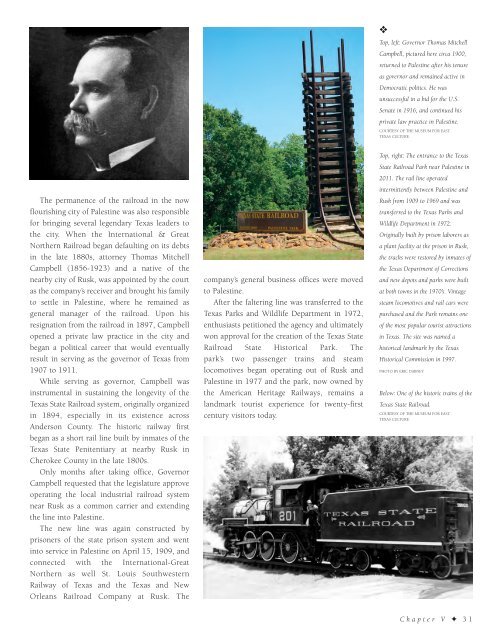Historic Palestine
An illustrated history of the Palestine, Texas area, paired with the histories of companies, families and organizations that make the region great.
An illustrated history of the Palestine, Texas area, paired with the histories of companies, families and organizations that make the region great.
You also want an ePaper? Increase the reach of your titles
YUMPU automatically turns print PDFs into web optimized ePapers that Google loves.
❖<br />
Top, left: Governor Thomas Mitchell<br />
Campbell, pictured here circa 1900,<br />
returned to <strong>Palestine</strong> after his tenure<br />
as governor and remained active in<br />
Democratic politics. He was<br />
unsuccessful in a bid for the U.S.<br />
Senate in 1916, and continued his<br />
private law practice in <strong>Palestine</strong>.<br />
COURTESY OF THE MUSEUM FOR EAST<br />
TEXAS CULTURE.<br />
The permanence of the railroad in the now<br />
flourishing city of <strong>Palestine</strong> was also responsible<br />
for bringing several legendary Texas leaders to<br />
the city. When the International & Great<br />
Northern Railroad began defaulting on its debts<br />
in the late 1880s, attorney Thomas Mitchell<br />
Campbell (1856-1923) and a native of the<br />
nearby city of Rusk, was appointed by the court<br />
as the company’s receiver and brought his family<br />
to settle in <strong>Palestine</strong>, where he remained as<br />
general manager of the railroad. Upon his<br />
resignation from the railroad in 1897, Campbell<br />
opened a private law practice in the city and<br />
began a political career that would eventually<br />
result in serving as the governor of Texas from<br />
1907 to 1911.<br />
While serving as governor, Campbell was<br />
instrumental in sustaining the longevity of the<br />
Texas State Railroad system, originally organized<br />
in 1894, especially in its existence across<br />
Anderson County. The historic railway first<br />
began as a short rail line built by inmates of the<br />
Texas State Penitentiary at nearby Rusk in<br />
Cherokee County in the late 1800s.<br />
Only months after taking office, Governor<br />
Campbell requested that the legislature approve<br />
operating the local industrial railroad system<br />
near Rusk as a common carrier and extending<br />
the line into <strong>Palestine</strong>.<br />
The new line was again constructed by<br />
prisoners of the state prison system and went<br />
into service in <strong>Palestine</strong> on April 15, 1909, and<br />
connected with the International-Great<br />
Northern as well St. Louis Southwestern<br />
Railway of Texas and the Texas and New<br />
Orleans Railroad Company at Rusk. The<br />
company’s general business offices were moved<br />
to <strong>Palestine</strong>.<br />
After the faltering line was transferred to the<br />
Texas Parks and Wildlife Department in 1972,<br />
enthusiasts petitioned the agency and ultimately<br />
won approval for the creation of the Texas State<br />
Railroad State <strong>Historic</strong>al Park. The<br />
park’s two passenger trains and steam<br />
locomotives began operating out of Rusk and<br />
<strong>Palestine</strong> in 1977 and the park, now owned by<br />
the American Heritage Railways, remains a<br />
landmark tourist experience for twenty-first<br />
century visitors today.<br />
Top, right: The entrance to the Texas<br />
State Railroad Park near <strong>Palestine</strong> in<br />
2011. The rail line operated<br />
intermittently between <strong>Palestine</strong> and<br />
Rusk from 1909 to 1969 and was<br />
transferred to the Texas Parks and<br />
Wildlife Department in 1972.<br />
Originally built by prison laborers as<br />
a plant facility at the prison in Rusk,<br />
the tracks were restored by inmates of<br />
the Texas Department of Corrections<br />
and new depots and parks were built<br />
at both towns in the 1970’s. Vintage<br />
steam locomotives and rail cars were<br />
purchased and the Park remains one<br />
of the most popular tourist attractions<br />
in Texas. The site was named a<br />
historical landmark by the Texas<br />
<strong>Historic</strong>al Commission in 1997.<br />
PHOTO BY ERIC DABNEY.<br />
Below: One of the historic trains of the<br />
Texas State Railroad.<br />
COURTESY OF THE MUSEUM FOR EAST<br />
TEXAS CULTURE.<br />
C h a p t e r V ✦ 3 1
















